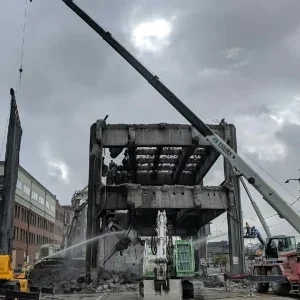
Introduction
In today’s digital age, the cranes industry, like many other sectors, is increasingly dependent on advanced technologies to enhance operational efficiency, safety, and productivity. However, this reliance on digital systems also introduces significant cybersecurity risks. Cyber insecurity can disrupt operations, compromise sensitive data, and cause financial losses. This article explores the various facets of cyber insecurity in the cranes industry, highlighting potential threats, their impacts, and the strategies that can be implemented to mitigate these risks.
The rise of digitalisation in the cranes industry
Technological advancements
The cranes industry has witnessed remarkable technological advancements over the past few decades. Key innovations include:
- IoT-Enabled Cranes: Internet of Things (IoT) technology enables real-time monitoring and control of crane operations, improving efficiency and safety.
- Automation and Robotics: Automated cranes reduce human error and increase precision in material handling and construction tasks.
- Remote Monitoring and Control: Advanced software systems allow for the remote monitoring and control of cranes, facilitating better project management and operational oversight.
- Predictive Maintenance: Data analytics and machine learning algorithms help predict equipment failures, allowing for timely maintenance and reducing downtime.
Benefits of digitalisation
These technological advancements offer several benefits, including:
- Increased Productivity: Automated systems streamline operations, reducing the time and labour required for complex tasks.
- Enhanced Safety: Real-time monitoring and remote control capabilities reduce the risk of accidents and improve overall safety.
- Cost Efficiency: Predictive maintenance and optimised operations result in significant cost savings.
- Data-Driven Decision Making: Access to real-time data and analytics enables better decision-making and project management.
Cyber security threats in the cranes industry
Types of cyber threats
The increasing digitalisation of the cranes industry exposes it to various cyber threats, including:
- Malware and Ransomware: Malicious software can infiltrate crane control systems, causing operational disruptions and demanding ransom payments to restore functionality.
- Phishing Attacks: Deceptive emails and messages trick employees into revealing sensitive information or installing malware.
- Insider Threats: Employees with access to sensitive systems and data can intentionally or unintentionally cause security breaches.
- Network Intrusions: Hackers can exploit vulnerabilities in network infrastructure to gain unauthorised access to crane control systems and data.
- Supply Chain Attacks: Cyber attackers can target third-party suppliers and service providers, compromising the security of the cranes industry through interconnected systems.
Real-world incidents
Several high-profile cyber attacks have highlighted the vulnerabilities in industrial sectors, including:
- The 2017 WannaCry Attack: This ransomware attack affected numerous industries worldwide, disrupting operations and causing significant financial losses.
- The 2020 SolarWinds Attack: Hackers infiltrated the systems of SolarWinds, a major IT service provider, compromising the security of multiple industries, including construction and logistics.
- The 2021 Colonial Pipeline Attack: A ransomware attack on Colonial Pipeline’s network led to a temporary shutdown of fuel supply lines, demonstrating the potential impact of cyber attacks on critical infrastructure.
Impacts of cyber insecurity on the cranes industry
Operational disruptions
Cyber attacks can cause significant operational disruptions in the cranes industry, including:
- System Downtime: Infected or compromised systems may need to be shut down for repairs and security enhancements, leading to project delays.
- Loss of Data: Cyber attacks can result in the loss or theft of sensitive data, including project plans, financial records, and client information.
- Safety Risks: Compromised control systems can malfunction, leading to accidents and injuries on construction sites.
Financial losses
The financial implications of cyber attacks can be substantial, encompassing:
- Ransom Payments: Companies may be forced to pay ransoms to regain access to their systems and data.
- Repair and Recovery Costs: Restoring compromised systems and implementing security upgrades can be costly.
- Legal and Regulatory Penalties: Non-compliance with data protection regulations can result in legal penalties and fines.
- Reputational Damage: Cyber attacks can damage a company’s reputation, leading to loss of business and client trust.
Regulatory and Compliance Challenges
The cranes industry must navigate an increasingly complex regulatory landscape to ensure compliance with cyber security standards. Key regulations include:
- GDPR: The General Data Protection Regulation imposes strict requirements on data protection and privacy for companies operating in the European Union.
- NIS Directive: The Network and Information Systems Directive mandates that essential service providers implement robust cyber security measures.
- ISO/IEC 27001: This international standard provides a framework for establishing, implementing, and maintaining an effective information security management system.
Strategies for mitigating cyber security risks
Implementing robust security measures
To safeguard against cyber threats, companies in the cranes industry should implement the following security measures:
- Firewalls and intrusion detection systems: Deploying firewalls and intrusion detection systems to monitor and block suspicious activities.
- Encryption: Encrypting sensitive data to protect it from unauthorised access during transmission and storage.
- Access Controls: Implementing strict access controls to limit system access to authorised personnel only.
- Regular updates and patching: Keeping software and systems up to date with the latest security patches and updates to mitigate vulnerabilities.
Employee Training and Awareness
Human error is a significant factor in many cybersecurity incidents. Companies should invest in employee training and awareness programmes to:
- Recognise phishing attacks: Educate employees on how to identify and report phishing attempts.
- Secure password practices: Promote the use of strong, unique passwords and regular password changes.
- Incident reporting: Encourage employees to report suspicious activities and potential security breaches promptly.
Incident Response Planning
Having a well-defined incident response plan is crucial for minimising the impact of cyber attacks. Key components of an effective incident response plan include:
- Detection and analysis: Establishing processes for the early detection and analysis of security incidents.
- Containment and eradication: Implementing strategies to contain and eradicate threats to prevent further damage.
- Recovery and restoration: Developing procedures to restore compromised systems and data, ensuring business continuity.
- Post-incident review: Conducting a thorough review of incidents to identify lessons learned and improve future responses.
Partnering with Cyber Security Experts
Collaborating with cyber security experts and service providers can enhance a company’s security posture. Benefits of such partnerships include:
- Expertise and Resources: Access to specialised knowledge and resources for addressing complex cyber security challenges.
- Proactive Threat Monitoring: Continuous monitoring and threat intelligence to identify and mitigate potential risks.
- Compliance Support: Assistance in achieving and maintaining compliance with regulatory requirements.
Future trends in cyber security for the cranes industry
Advancements in security technologies
Emerging technologies offer new opportunities for enhancing cyber security in the cranes industry, including:
- Artificial intelligence and machine learning: AI and machine learning can improve threat detection and response capabilities by analysing patterns and identifying anomalies in real-time.
- Blockchain technology: Blockchain can provide secure, tamper-proof records of transactions and communications, enhancing data integrity and trust.
- Quantum computing: While still in its early stages, quantum computing holds the potential to revolutionise cryptography and enhance the security of digital systems.
Increasing focus on supply chain security
As cyber attacks on supply chains become more prevalent, companies in the cranes industry must:
- Assess Supplier Security: Conduct thorough security assessments of third-party suppliers and service providers.
- Implement Security Standards: Require suppliers to adhere to established cyber security standards and best practices.
- Monitor and Mitigate Risks: Continuously monitor supply chain activities for potential security threats and implement mitigation strategies.
Strengthening regulatory frameworks
Governments and regulatory bodies are likely to introduce more stringent cyber security regulations in response to evolving threats. Companies should stay informed about regulatory developments and ensure compliance with new requirements.
Conclusion
Cyber insecurity poses significant risks to the cranes industry, threatening operational continuity, financial stability, and regulatory compliance. As the industry continues to embrace digitalisation, it must also prioritise the implementation of robust cyber security measures. By adopting a proactive approach to cyber security, investing in employee training, and leveraging advanced technologies, the cranes industry can mitigate the risks of cyber attacks and ensure a secure, resilient future. The path forward involves not only safeguarding against current threats but also anticipating and preparing for future challenges. Through collaboration, innovation, and a commitment to security best practices, the cranes industry can navigate the complex cyber security landscape and thrive in the digital age.






